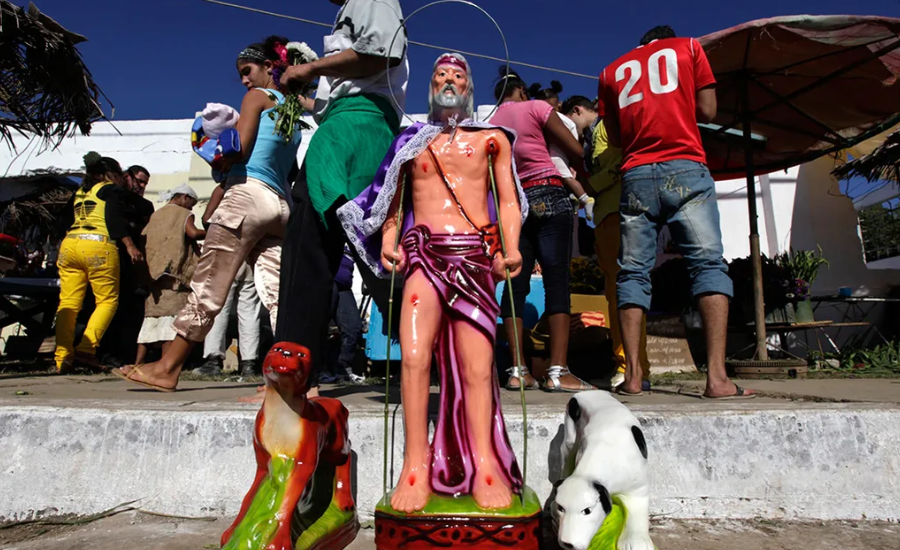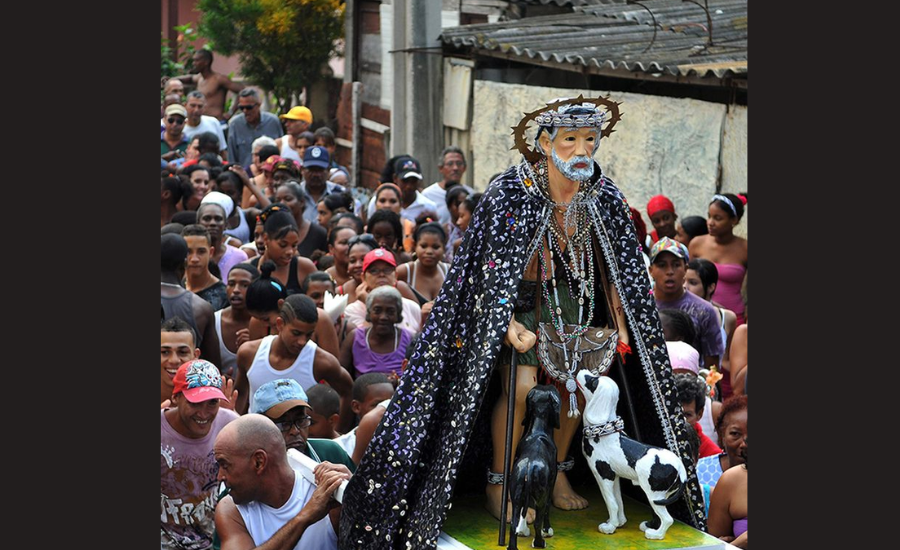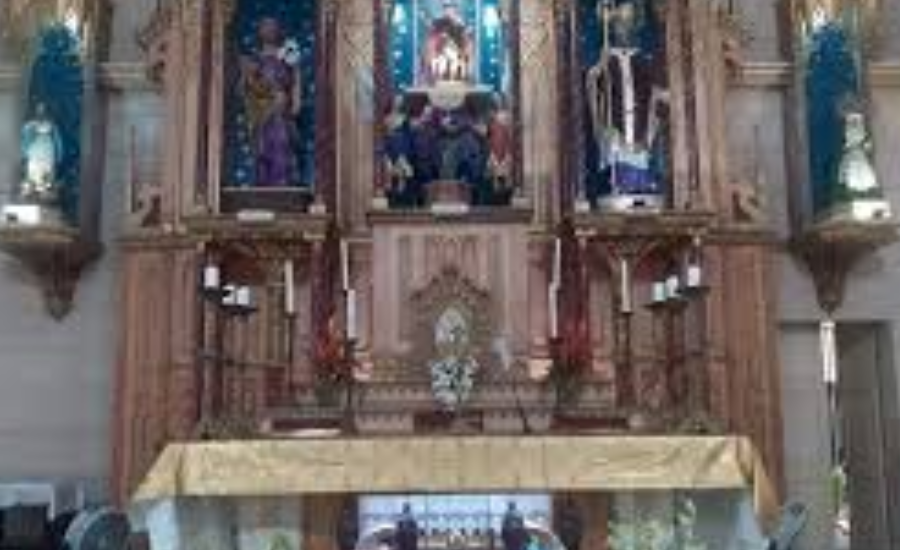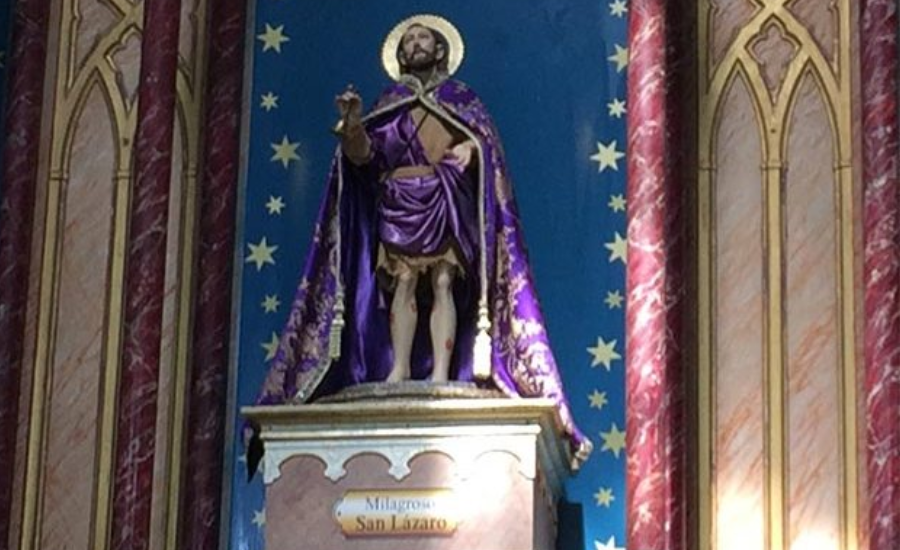When you hear the name St. Lazarus, the first figure that likely comes to mind is the biblical character who was famously raised from the dead by Jesus Christ. However, the figure of St. Lazarus Abba Kwi holds a distinct and profound spiritual significance within the Afro-Cuban religious traditions, far beyond the biblical narrative. In Cuba, St. Lazarus Abba Kwi is more than a saint; he embodies a unique blend of cultural and religious beliefs, particularly within the practices of Santería, an Afro-Cuban religion that merges Yoruba traditions with Catholicism.
What Is St. Lazarus Abba Kwi Cuban?

St. Lazarus Abba Kwi, known in Afro-Cuban religious practices as Babalu Aye, stands as a central and revered figure within Santería—an Afro-Cuban religion that intricately weaves together Yoruba traditions and Catholic beliefs. In this spiritual context, St. Lazarus Abba Kwi is venerated as a powerful healer and guardian, especially for those who are afflicted by sickness and disease. His role goes beyond the confines of religious practices, as he has become an enduring symbol of compassion, healing, and protection in Cuban culture at large. His influence is so profound that it resonates with people across various religious backgrounds, highlighting his deep-rooted significance in the collective Cuban identity.
A Brief Overview Of Santería
To fully appreciate the significance of St. Lazarus Abba Kwi Cuban, it’s important to delve into the religious framework in which his veneration is deeply rooted—Santería. Also known as Regla de Ocha, Santería is an Afro-Cuban religion that emerged during the era of the transatlantic slave trade. Enslaved Africans, primarily from the Yoruba ethnic group, were forcibly brought to the Caribbean, carrying with them their rich religious beliefs and practices. These spiritual traditions gradually intertwined with Roman Catholicism, leading to the formation of a unique syncretic religion where Yoruba deities, called Orishas, were synchronized with Catholic saints.
Babalu Aye, who is venerated as St. Lazarus in Catholicism, is one of the most revered Orishas within Santería. His role as a healer and protector is central to the faith, and his worship exemplifies the intricate blending of African and Catholic religious practices that characterize Santería. Through this syncretism, Babalu Aye, or St. Lazarus Abba Kwi, has become a potent symbol of spiritual resilience, healing, and cultural identity in Cuban society.
The Origins Of St. Lazarus Abba Kwi Cuban
The name “Abba Kwi” is thought to originate from the Yoruba language, where “Abba” translates to “father” and “Kwi” denotes a powerful or esteemed individual. This etymology underscores the profound respect and devotion that followers of St. Lazarus hold, especially within the rich cultural tapestry of Cuba.
While many are familiar with the biblical figure of Lazarus, who was famously raised from the dead by Jesus Christ, the St. Lazarus revered in Cuban traditions diverges significantly from this biblical narrative. In Cuban culture, St. Lazarus is more intimately connected with Babalu Aye, an Orisha associated with illness, healing, and protection in the Santería religion. This fusion of the Catholic St. Lazarus and the Yoruba deity Babalu Aye has given rise to a distinctive form of devotion in Cuban society. Here, St. Lazarus Abba Kwi is not merely a saint but also a powerful spiritual figure who embodies the dual forces of suffering and healing. His followers venerate him not only for his saintly virtues but also for his formidable healing powers, making him a deeply revered and significant figure in both religious and cultural contexts across Cuba.
The Cultural Significance Of St. Lazarus Abba Kwi In Cuba

St. Lazarus Abba Kwi holds a place of profound reverence throughout Cuba, transcending the confines of the Santería faith to touch the lives of people from diverse religious and cultural backgrounds. His influence is so pervasive that even individuals who do not actively practice any religion often hold him in high esteem. This widespread veneration is most prominently observed on December 17th, known as the Feast Day of St. Lazarus. On this day, Cubans from all walks of life participate in a variety of rituals, including pilgrimages, prayers, and offerings, as they seek his blessings and give thanks. The day is marked by a deep sense of devotion and unity, as people come together to honor a figure who represents healing, protection, and hope, making St. Lazarus Abba Kwi an enduring symbol of cultural and spiritual identity across the nation.
The Pilgrimage To El Rincón
Each year, one of the most profound and culturally significant events in Cuba unfolds with the pilgrimage to the Church of El Rincón, situated just outside Havana. This pilgrimage, dedicated to St. Lazarus, draws thousands of devotees who embark on this spiritual journey to honor their promises, express their gratitude, and seek blessings from the revered saint. The devotion displayed during this event is palpable; many pilgrims endure long, arduous treks, with some choosing to walk barefoot or even crawl on their knees, as an act of penance or profound dedication.
This pilgrimage is not merely a religious ritual but a powerful testament to the deep-rooted connection between St. Lazarus Abba Kwi and the Cuban people. It serves as a vibrant expression of faith, intertwining tradition and cultural identity in a way that underscores the integral role this figure plays in the collective Cuban consciousness. The act of pilgrimage itself becomes a symbolic journey, reflecting the resilience, hope, and enduring spirit of those who revere St. Lazarus, solidifying his place not just as a religious icon but as a cornerstone of Cuban cultural heritage.
St. Lazarus In Afro-Cuban Religions
In the rich tapestry of Santería and other Afro-Cuban religious practices, Babalu Aye—also known as St. Lazarus—is venerated as a powerful deity with the profound ability to heal those afflicted by diseases, particularly ailments of the skin, bones, and other infectious conditions. His revered image often portrays him as an elderly figure, frail and bent, leaning on crutches for support. This portrayal is deeply symbolic, representing not only his own experiences of suffering and hardship but also his boundless compassion and protective nature towards those who are sick or marginalized.
Accompanying Babalu Aye are two loyal dogs, a key element in his iconography. These animals are more than mere companions; they are emblematic of loyalty, healing, and the unconditional care that Babalu Aye extends to his followers. The imagery of the dogs, often seen tending to their master’s wounds, further emphasizes the themes of humility, endurance, and the redemptive power of faith that Babalu Aye embodies. In this way, Babalu Aye’s depiction transcends mere religious symbolism, offering a powerful narrative of resilience and the transformative power of suffering turned into compassion and healing.
Devotional Practices And Offerings
Worship of St. Lazarus Abba Kwi, a revered figure in Afro-Cuban religious traditions, is deeply rooted in rituals and symbolic offerings. Devotees engage in a variety of practices, presenting gifts such as food, candles, flowers, and cigars at altars or sacred spaces dedicated to him. These offerings are more than mere gestures; they are acts of devotion believed to invoke St. Lazarus’s blessings and protection. Each item carries specific significance—food to nourish, candles to light the way, flowers to honor, and cigars as a symbol of respect.
Many worshippers also make heartfelt vows, known as promesas, during times of illness or personal hardship, pledging to perform specific acts of devotion if their prayers for healing or guidance are answered. These promises often manifest in the form of pilgrimages, where individuals journey to sacred sites, sometimes enduring physical hardships like walking long distances barefoot or on their knees. Others may fulfill their vows through charitable acts, giving back to the community in St. Lazarus’s name, or by offering something of personal value to him. These rituals not only reflect the deep spiritual connection devotees have with St. Lazarus Abba Kwi but also underscore the powerful role that faith and commitment play in their daily lives.
The Symbolism Of Dogs In The Devotion To St. Lazarus

One of the most compelling and symbolic aspects of St. Lazarus Abba Kwi’s imagery is his close association with dogs. In traditional depictions of Babalu Aye, who is equated with St. Lazarus in Afro-Cuban religious practices, he is nearly always portrayed in the company of two loyal dogs. This imagery is rich with meaning, embodying themes of loyalty, compassion, and the dignity of those who endure suffering.
The presence of the dogs is not merely decorative; it is deeply symbolic. These animals are seen as faithful companions who remain devoted even in times of hardship and marginalization. In this context, the dogs serve as a poignant reminder that every individual, regardless of their circumstances or status, is deserving of compassion and care. This resonates powerfully within Cuban culture, where dogs are often regarded as symbols of unwavering loyalty and protection.
The bond between St. Lazarus and his dogs also reflects a broader societal message: that those who are often overlooked, such as the sick, the poor, and the marginalized, have inherent worth and should be treated with kindness and respect. This symbolism adds a layer of depth to the veneration of St. Lazarus Abba Kwi, emphasizing that his role as a healer and protector extends not just to the physically ill but to all who suffer or are in need of support. Through this imagery, St. Lazarus becomes a beacon of hope and humanity, advocating for the dignity and care of all beings.
The Syncretism Of Catholicism And Santería In Cuban Culture

The veneration of St. Lazarus Abba Kwi in Cuban culture serves as a striking example of religious syncretism, where disparate spiritual traditions merge to create a unified and distinctive practice. This phenomenon is particularly evident in the blending of Catholic devotion to St. Lazarus with the Santería worship of Babalu Aye. The resulting fusion not only highlights the adaptability and resilience of religious traditions but also enriches the spiritual landscape for many Cubans.
In this unique syncretic practice, the Catholic portrayal of St. Lazarus as a frail, elderly figure is juxtaposed with the Santería depiction of Babalu Aye. Catholic imagery often presents St. Lazarus as a saint in a state of vulnerability, reflecting his biblical narrative of suffering and divine intervention. In contrast, Santería altars feature Babalu Aye adorned in humble burlap garments, with his body marked by sores and leaning on crutches. This depiction emphasizes his role as a deity associated with healing and protection, underscoring his deep connection to those afflicted by illness.
How St. Lazarus Abba Kwi Cuban Influences Modern Cuban Society
St. Lazarus Abba Kwi’s influence extends far beyond the realm of religious devotion, deeply affecting the cultural and social landscape of Cuba. His veneration is a testament to the resilience, faith, and hope that define the Cuban spirit, especially during challenging times. Cubans turn to St. Lazarus for protection and guidance, reflecting his pivotal role as a source of strength and reassurance.
The Role Of St. Lazarus In Health And Healing
In Cuban society, St. Lazarus Abba Kwi is a central figure in matters of health and healing. Devotees frequently turn to him when facing health issues, ranging from minor ailments to serious medical conditions. They pray to him with the belief that he has the power to alleviate suffering and bring about recovery. This deep-seated faith in his healing abilities is so profound that many attribute miraculous recoveries to his intercession, further cementing his status as a revered healer and protector.
The rituals and traditions surrounding St. Lazarus also offer emotional and psychological support, providing comfort to those in distress. Engaging in these practices fosters a sense of community, where shared devotion helps individuals find solace and strength. The communal aspect of these rituals enhances their therapeutic effect, creating a network of support that is both spiritually and emotionally beneficial.
Social And Cultural Celebrations
The Feast Day of St. Lazarus, held annually on December 17th, transcends its religious origins to become a major cultural event in Cuba. This celebration is marked by vibrant festivities that include music, dance, and communal feasts. It is a time when Cubans come together to honor St. Lazarus, reconnect with their cultural heritage, and celebrate the enduring spirit of resilience and hope that he represents.
During this day, the atmosphere is filled with joyous expressions of faith and unity. The celebration serves as an opportunity for people to reaffirm their connection to their roots, express their gratitude, and partake in the collective joy and solidarity that characterize this significant occasion. The Feast Day exemplifies how St. Lazarus Abba Kwi’s influence permeates not just the religious sphere but also the broader cultural and social fabric of Cuban life.
The Global Reach Of St. Lazarus Abba Kwi Cuban Devotion
Though St. Lazarus Abba Kwi is deeply rooted in Cuban culture, his influence has extended well beyond the island’s shores. The Cuban diaspora, particularly in cities with significant Cuban communities such as Miami, has carried this rich tradition to new locales around the world. In these communities, St. Lazarus is venerated with the same fervor and reverence as in Cuba, demonstrating the enduring significance of his role.
In cities like Miami, where the Cuban population is vibrant and sizable, St. Lazarus’s presence is notably prominent. Local celebrations, rituals, and communal events dedicated to him reflect a continuity of devotion and cultural heritage. These practices serve as a testament to the powerful connection that many Cubans, both native and abroad, maintain with St. Lazarus. His message of hope, healing, and protection transcends geographical boundaries, resonating deeply with individuals no matter where they are located.
The global spread of St. Lazarus Abba Kwi’s veneration underscores his universal appeal and the profound impact he has on his devotees. It highlights how cultural and spiritual practices can maintain their relevance and importance even as communities relocate and adapt to new environments. The ongoing reverence for St. Lazarus not only bridges the gap between the past and present but also connects disparate communities through shared beliefs and values.
The Connection Between St. Lazarus And Other Religious Traditions
St. Lazarus Abba Kwi, while deeply rooted in Santería and Catholicism, also shares notable parallels with practices found in other religious traditions. In Catholicism, the veneration of saints often mirrors the worship of deities in Afro-Caribbean religions such as Vodou in Haiti. Both systems of belief involve seeking the favor of powerful spiritual beings who can influence human lives, offering protection, healing, and guidance.
In Catholicism, saints are revered for their ability to intercede on behalf of the faithful, providing spiritual support and miracles. Similarly, in Vodou, spirits known as loa or orishas play a crucial role in the lives of devotees, offering assistance, protection, and answers to their prayers. This comparison highlights a shared human quest for spiritual intervention and support across various cultures and religious practices.
The universal desire for spiritual support is a common thread that connects these diverse religious traditions. Whether through saints in Catholicism, deities in Santería, or loa in Vodou, people across different cultures seek out spiritual figures who can provide comfort, healing, and guidance. This broader connection underscores how various cultures express their spiritual needs and experiences through their unique religious practices, reflecting a universal quest for meaning, support, and connection with the divine.
Key Takeaways About St. Lazarus Abba Kwi Cuban
- St. Lazarus Abba Kwi, a distinctive syncretic figure in Cuban spirituality, embodies the fusion of Catholic and Yoruba religious traditions. He merges the Catholic St. Lazarus, known for his biblical resurrection, with the Yoruba deity Babalu Aye, revered in Afro-Cuban practices. This synthesis reflects the rich tapestry of Cuban religious life, where diverse spiritual elements intertwine to create a unique cultural identity.
- In the context of Santería, an Afro-Cuban religion that blends Yoruba beliefs with Catholicism, St. Lazarus Abba Kwi holds a revered position as both a healer and protector. His role extends beyond mere religious significance; he symbolizes the enduring strength and hope of the Cuban people. His association with healing, particularly concerning diseases and ailments, underscores his importance in the lives of many Cubans who seek his intercession for health and protection.
- One of the most profound expressions of devotion to St. Lazarus Abba Kwi is the annual pilgrimage to El Rincón, a small town near Havana. This pilgrimage is not just a religious observance but a major cultural event that draws thousands of devotees from across Cuba. Pilgrims undertake arduous journeys, often walking long distances or performing acts of penance, to reach the Church of El Rincón. This event highlights the deep spiritual connection and communal faith that define the veneration of St. Lazarus in Cuban society.
- The veneration of St. Lazarus Abba Kwi is a testament to the blending of Catholic and Yoruba traditions, a hallmark of Afro-Cuban religious practices. His dual identity as both a saint and an orisha illustrates the complex and rich nature of Cuban spirituality. In this syncretic framework, St. Lazarus represents not only a spiritual guide and healer but also a symbol of resilience and hope, reflecting the profound cultural and spiritual life of Cuba.
Frequently Asked Questions (FAQ) About St. Lazarus Abba Kwi Cuban
Q: Who is St. Lazarus Abba Kwi in Cuban culture?
A: St. Lazarus Abba Kwi, also known as Babalu Aye, is a revered figure in Cuban culture, especially within Santería. He is celebrated as a powerful healer and protector, with his veneration reflecting a unique fusion of Catholic and Yoruba traditions.
Q: What is St. Lazarus Abba Kwi’s connection to Santería?
A: In Santería, St. Lazarus Abba Kwi is associated with Babalu Aye, an Orisha known for his healing powers and protective role. This connection represents the blending of Catholic and Yoruba religious elements into a distinct Afro-Cuban spiritual practice.
Q: What is the significance of the El Rincón pilgrimage?
A: The pilgrimage to El Rincón, held annually on December 17th, is a major religious and cultural event in Cuba. Devotees travel long distances, often barefoot or on their knees, to honor St. Lazarus Abba Kwi, symbolizing deep faith and cultural identity.
Q: Why are dogs associated with St. Lazarus Abba Kwi?
A: St. Lazarus Abba Kwi is traditionally depicted with two dogs, symbolizing loyalty, compassion, and care for the suffering. This imagery underscores the belief that even those who are ill or marginalized deserve empathy and protection.
Q: How does St. Lazarus Abba Kwi impact Cuban culture beyond religion?
A: St. Lazarus Abba Kwi’s influence extends beyond religious practices, affecting Cuban culture through social and cultural events. His veneration embodies resilience, faith, and hope, playing a key role in maintaining cultural identity and community bonds.
Conclusion
St. Lazarus Abba Kwi, also known as Babalu Aye in Afro-Cuban traditions, embodies healing, protection, and resilience in Cuban culture. His worship is a blend of Catholic and Yoruba beliefs, creating a rich spiritual identity for many Cubans. Devotion to him is shown through rituals and the significant annual pilgrimage to El Rincón, highlighting the deep spiritual and cultural connection his followers have with him. His influence spans beyond religious boundaries, touching various aspects of Cuban life and the diaspora. St. Lazarus Abba Kwi stands as a symbol of enduring faith, humility, and the strength of cultural identity.
For ongoing updates and alerts, make sure to check out: Galen Me Tzger1!
